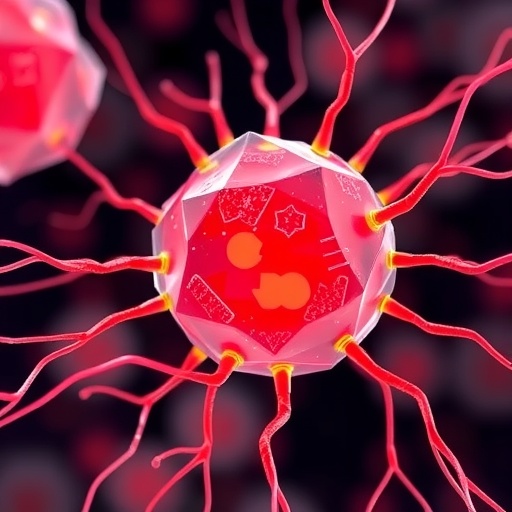Cellular motility is a fundamental phenomenon underpinning numerous biological processes, from the invasive spread of cancer cells to the directed migration of immune cells during wound healing. Despite its critical importance, the intrinsic mechanisms enabling cells to autonomously decide their direction of movement without reliance on extrinsic cues have remained elusive. Recently, a pioneering research collaboration led by scientists at KAIST in conjunction with Johns Hopkins University has shed unprecedented light on this enigma, unveiling the molecular machinery governing autonomous cellular navigation.
At the heart of this breakthrough lies the discovery of an ‘autonomous driving mechanism’ within cells that dictates directional movement in the absence of external signals. Spearheaded by Professor Won Do Heo and his interdisciplinary team, the study deconstructed how cells internally orchestrate their motility programs through a sophisticated ensemble of protein interactions. This newfound understanding presents transformative implications for decoding the drivers of metastatic cancer and immune system dysregulation.
Central to the investigation was the development of an innovative imaging technique dubbed INSPECT (INtracellular Separation of Protein Engineered Condensation Technique). This technological advancement permits real-time visualization of protein interactions inside living cells by harnessing engineered phase separation phenomena. Phase separation involves the compartmentalization of proteins into condensates, akin to tiny droplets that segregate within the cellular milieu, allowing researchers to observe binding events with remarkable clarity via fluorescent markers.
Leveraging INSPECT, the researchers scrutinized the behavior of Rho family GTPases—specifically Rac1, Cdc42, and RhoA—which are well-known molecular switches regulating cytoskeletal dynamics and cellular locomotion. Prior hypotheses largely attributed cell polarity and motion to spatial segregation of these proteins; however, this study revealed a far more nuanced picture. The direction a cell chooses hinges not merely on protein localization but critically on which particular binding partners the Rho GTPases engage with, establishing distinct signaling circuits that govern straight movement or directional changes.
To visualize these interactions, the team engineered protein clusters using ferritin as a scaffold and DsRed, a fluorescent protein, as a reporter. This enabled detection of 139 binding pairs out of 285 tested combinations between 15 Rho GTPases and 19 effector proteins. Among these, the Cdc42-FMNL interaction emerged as integral to promoting persistent, straight-line migration, while the Rac1-ROCK partnership orchestrated the cellular ability to effectuate directional turns by constructing structural adaptations known as arc stress fibers.
The functional significance of these molecular partnerships was further substantiated through targeted mutagenesis experiments. Modifying the 37th amino acid residue of Rac1, critical for its binding affinity with ROCK, effectively incapacitated the cell’s steering mechanism without affecting its forward propulsion. Consequently, mutant cells lost the capacity to navigate changes in their environment and instead proceeded in rigid linear trajectories, underscoring the Rac1-ROCK axis as a molecular fulcrum for motility adaptability.
Additionally, the dynamic assembly of arc stress fibers facilitated by Rac1-ROCK interactions was observed to enable near-perpendicular directional shifts, a capability vital for cells responding to complex microenvironments. Normal cells modulated their migration speed in response to varying substrates, whereas mutant cells with disrupted Rac1-ROCK binding exhibited speed invariance, revealing the biochemical basis for environmental sensing during cell migration.
Professor Won Do Heo emphasized the paradigm shift introduced by these findings, asserting that cell movement should be reframed not as stochastic drift but as a precisely choreographed process dictated by an intrinsic regulatory network. The ensemble of Rho GTPases and their effectors form an intricate signaling nexus that encodes cellular decision-making in migration, which could be exploited for therapeutic interventions targeting metastatic cancer and immune disorders.
The versatility of the INSPECT platform extends beyond this single study, positioning it as a powerful toolset for probing intracellular molecular interactions with high spatiotemporal resolution. By illuminating the composition and function of protein condensates in live cells, INSPECT opens new avenues for investigating pathological mechanisms in neurobiology, oncology, and beyond.
Published in the prestigious journal Nature Communications, this research exemplifies the synergy achievable through interdisciplinary collaboration across biological sciences and bioengineering. It also highlights the vital role of cutting-edge imaging technologies in deciphering complex cellular behaviors that were previously inscrutable.
As the field advances, the detailed mechanistic insights provided by this work pave the way for novel strategies that could manipulate cell migration patterns, offering hope for mitigating the spread of malignant cells and enhancing tissue regeneration. The modulation of Rho GTPase-effector interactions represents a promising frontier in translational medicine aimed at controlling cellular dynamics at the molecular level.
In conclusion, the elucidation of the autonomous regulatory circuits that govern cell motility marks a significant milestone in cell biology. This research not only deepens our understanding of the molecular code driving directional migration but also heralds new potential for clinical applications targeting diseases characterized by aberrant cell movement.
Subject of Research: Cell migration and intracellular protein interactions.
Article Title: A Rho GTPase-effector ensemble governs cell migration behavior.
News Publication Date: 10 November 2025.
Web References: DOI: 10.1038/s41467-025-64635-0.
Image Credits: KAIST.
Keywords: Cell biology, Rho GTPase, protein phase separation, cellular motility, INSPECT imaging technology, cancer metastasis, immune cell migration.




